Checkerboard Lace Scarf In Tussock
Our Checkboard Lace Scarf is nothing you can’t handle. Feather light and dreamy soft, it rewards the little bit of extra effort!
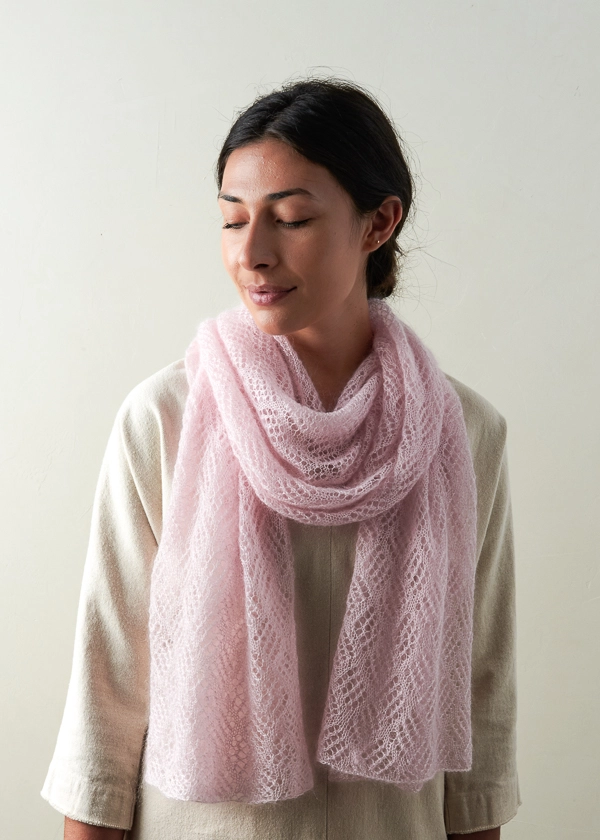
This pattern is really no more than a combo of yarn overs and standard issue decreases, all guided by one simple rule: every yarn-over hole makes a stitch and so requires a corresponding decrease to keep the stitch score even. Make a stitch here, take a stitch there, and watch a field of little diamond-shaped checkerboards grow!
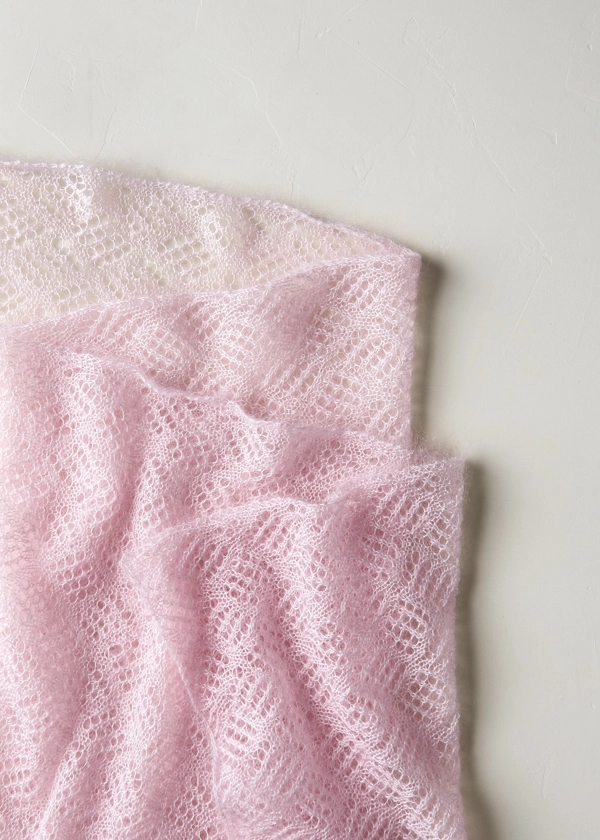
In our mohair-silk Tussock, our Checkerboard Lace Scarf is magically voluminous and downy soft. It’s also just the color you want now that we’ve added 17 new ones to the palette! Sweet and misty like the Apple Blossom pink we used here, or maybe deep and clear like our new Cerulean Sea, you’ll need just three skeins, some pointy needles, and some nice, quiet lace-making time!
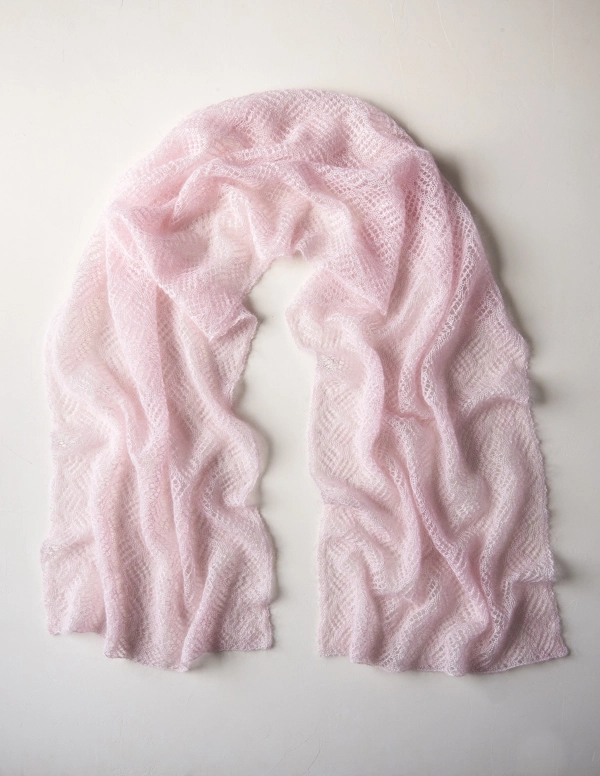
Designed by Purl Soho designer, Jake Canton. Click here to see even more of Jake’s designs!
Share your progress + connect with the community by tagging your pics with #PurlSoho, #PurlSohoBusyHands, #PurlSohoCheckerboardLaceScarf, and #PurlSohoTussock. We can’t wait to see what you make!
Materials
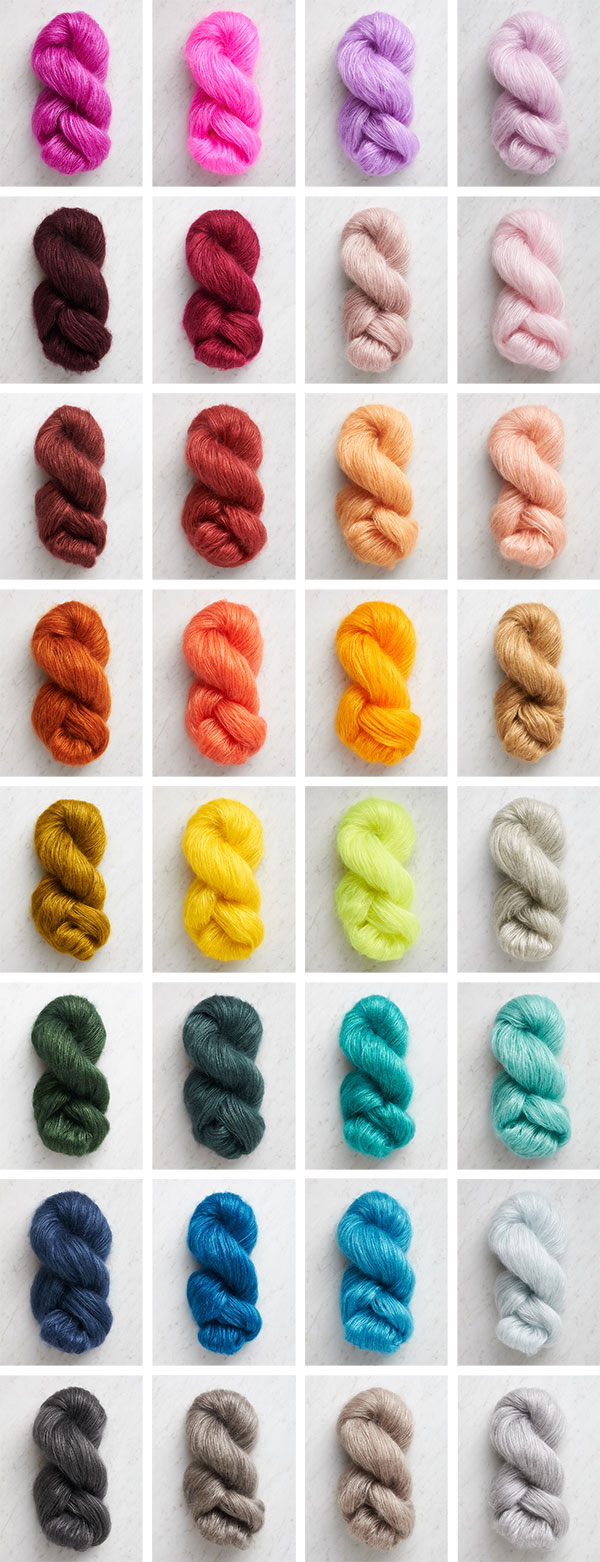
- 3 skeins of Purl Soho’s Tussock, 60% super fine kid mohair and 40% silk. Each skein is 328 yards/ 25 grams; approximately 984 yards required. We used the color Apple Blossom.
- US 4 (3.5 mm) circular or straight needles
Gauge
21¼ stitches and 41 rows = 4 inches in stitch pattern
Size
Finished Dimensions: 18½ inches wide x 71 inches long
Note
Stitch Multiple
This pattern works over a multiple of 10 + 8 stitches.
Pattern
Cast on 98 stitches, we used a Basic Long Tail Cast-On.
Row 1 (wrong side) and every odd numbered row: K2, purl to last 2 stitches, k2.
Row 2 (right side): K6, *yo, ssk, k1, [k2tog, yo] 2 times, k3, repeat from * to last 2 stitches, k2.
Row 4: K2, *k3, [yo, ssk] 2 times, k1, k2tog, yo, repeat from * to last 6 stitches, k6.
Row 6: K4, *[yo, ssk] 3 times, k4, repeat from * to last 4 stitches, yo, ssk, k2.
Row 8: K3, *[yo, ssk] 4 times, k2, repeat from * to last 5 stitches, yo, ssk, k3.
Row 10: Repeat Row 6.
Row 12: Repeat Row 4.
Row 14: Repeat Row 2.
Row 16: K2, k2tog, yo, *k4, [k2tog, yo] 3 times, repeat from * to last 4 stitches, k4.
Row 18: K3, k2tog, yo, *k2, [k2tog, yo] 4 times, repeat from * to last 3 stitches, k3.
Row 20: Repeat Row 16.
Repeat Rows 1-20 until piece measures 70 inches from cast-on edge, ending with Row 5.
With right side facing you, loosely bind off knitwise.
Weave in the ends and gently wet block.
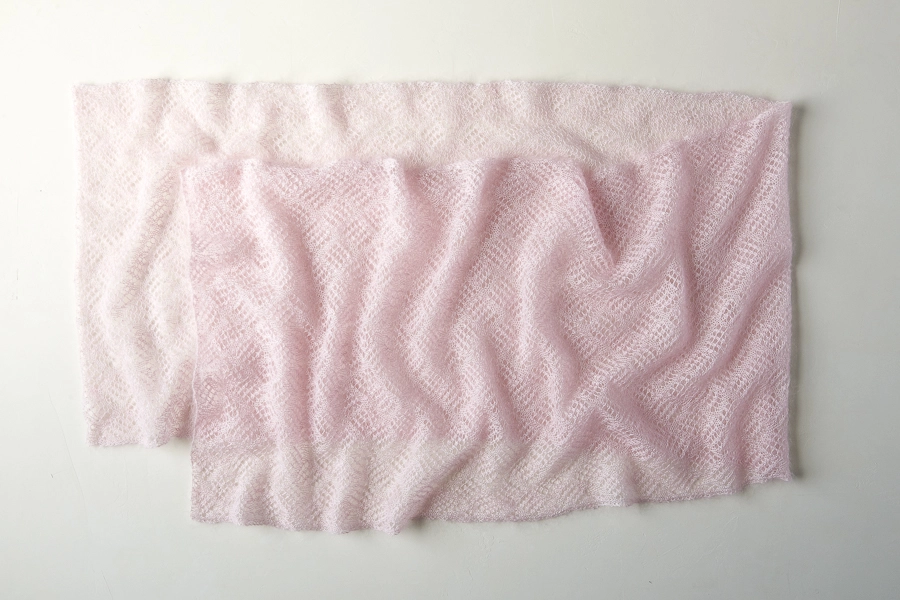
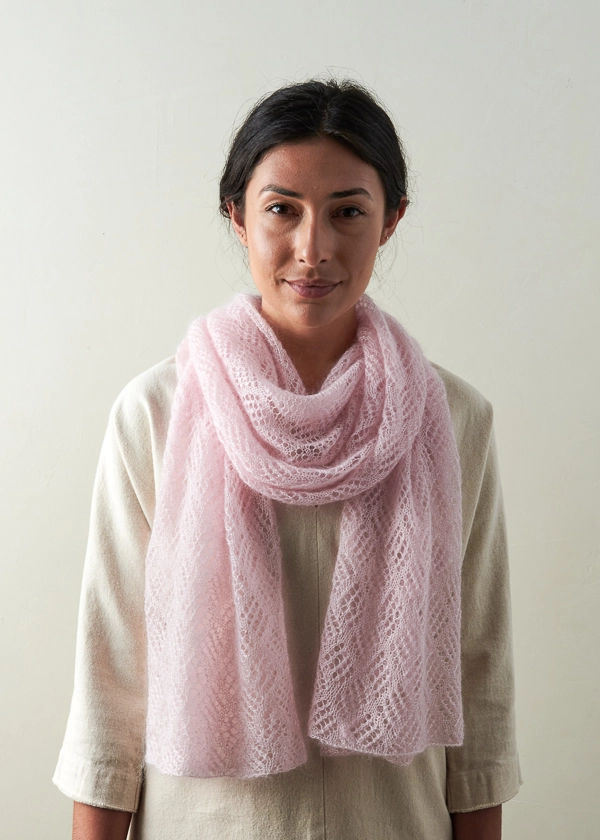

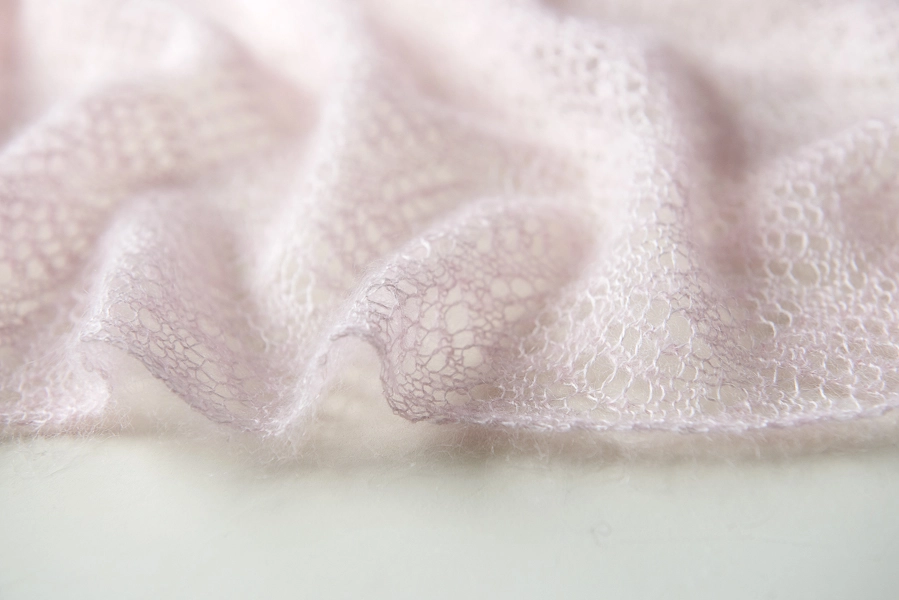

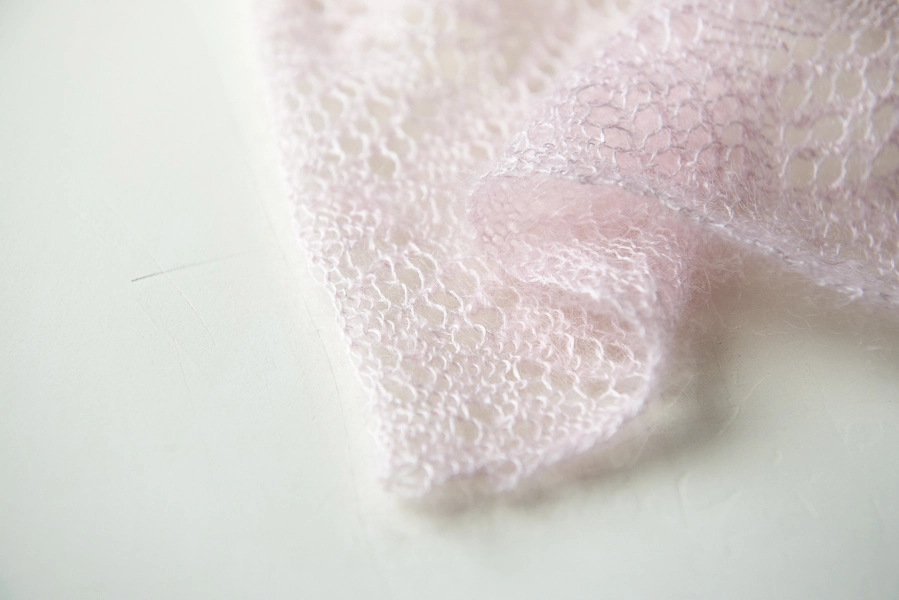
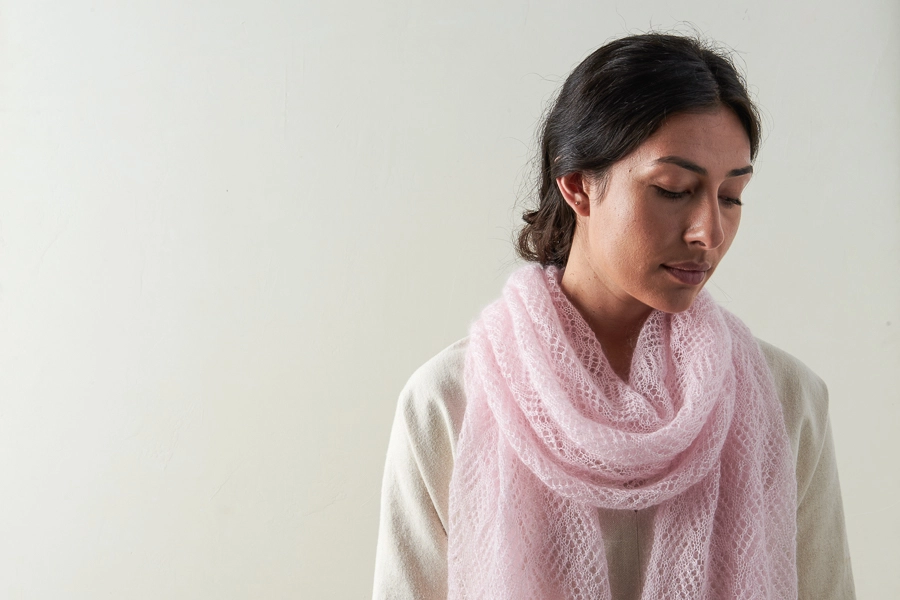


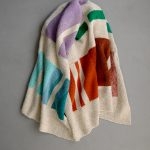
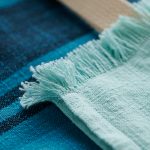
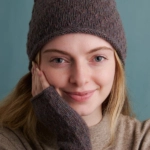

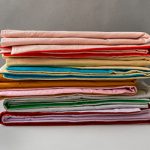
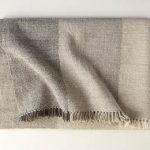
very lovely
WOW! this is absolutely gorgeous!
thank you so very much!
I’d like to make this into a blanket using the mMalibragos Rios. Can you please advise on how many stitches I should cast on?
Hi Mimi,
Thanks for reaching out! In order to determine your cast on amount, you will want to start off by working a gauge swatch with an appropriately sized needle (I believe for Rios they recommend a US 9). From there you can calculate your stitches per inch to determine your cast on amount! Just be sure to keep in mind that this pattern works over a multiple of 10 + 8 stitches. For example, for your swatch, I would suggest casting on either 28 or 38 stitches! For more information on gauge, I recommend checking out our wonderful tutorial, All About Gauge!
I hope this helps and please let me know if you have any more questions!
Gianna
Stunning, I have the puuuuurrrrfeect yarn in my stash. pure Soho!?
I am new to lace knitting, wondering if dark colors work as well as the pastels you show? And if your yarn called burnish would work for this scarf?
Hi Gwen,
Great question! While darker colored yarns will somewhat obscure complex lace patterns, the result can be mysteriously lovely! You might not want to pick a true black, both because it’s harder to see to knit with and because a lot of your hard work will be hidden in the final scarf, but a darker color like Tussock in Gray Quartz or Burnish in Prussian Blue would be just light enough to show off your fancy stitch work. And yes, Burnish would be a wonderful yarn to use for this scarf!
I hope that helps, and please do let us know how it turns out!
Julianna
If I was to do this with Posy, would it take the same number of skeins and needle size? Thanks!
Hi Alicia,
Thanks for writing in! I would suggest knitting a gauge swatch to see how Posy looks on the US 4 needles, but it should be just fine! You will actually need a fourth skein to make the scarf the same dimensions as ours, but will only need a very small amount of the fourth skein. If you don’t mind it being a few inches shorter, you could certainly get away with just three skeins!
Happy knitting!
Julianna
That pink is my absolute favorite color … this is a gorgeous scarf.
Is this yarn washable?
Hi Marny,
Thank you so much for the kind words! The care instructions for Tussock are to hand wash and lay flat to dry.
Best,
Julianna
i always hesitate to make gifts that have to be washed by hand and block. recipients don’t want to do that much work.
i love your yarn and am grateful to you for all the freebies. my list of :to do: is huge but love saving the patterns, just in case.
if anyone has broken a wrist, please write how long it took before you could knit and/or crochet again. this is very tiring, even to type using right wrist – still in physical therapy twice a week. ugh. thank you.
Hello Marny,
Thank you for reaching out and for your kind words.
Wishing you a swift recovery!
Best,
Marilla
Took me about 6 months before I could knit and crochet again, but honestly, there are still days that my wrist hurts from a break 3 years ago, as arthritis now plagues the joint. I still knit, just need to limit the duration on some days. Be patient; it seems like forever, but you will be back to it.
It is a while since I have been knitting. Could you clarify Row 2, and tell me what ssk means please?
Thank you. Wendy
Hi Wendy,
Thanks for writing in! SSK is a type of decrease, and you can see how to do it in our Slip Slip Knit (SSK) tutorial!
Best,
Julianna
This is a beautiful pattern and lovely, fluffy weight.
Can you recommend a yarn that is silk or cashmere for someone who is allergic to wool?
Thanks!
Hi Helen,
Thanks for reaching out! Tussock actually does not contain any wool – like cashmere, mohair comes from a breed of goat, not sheep, so many people who are sensitive to wool can wear mohair without any problems! If you prefer to avoid it, however, this scarf would be lovely in either Cattail Silk or Jade Sapphire 2-Ply Cashmere.
Happy knitting!
Julianna
I was wondering g if you can use a lace weight yarn for this gorgeous scarf.
Hi Gladys,
Great question! Tussock can knit up at either a lace or fingering weight gauge, so I do think a heavier lace weight yarn would work! I would recommend knitting and blocking a gauge swatch in pattern with your chosen yarn to make sure you will be happy with it on US 4 needles.
Best of luck and happy knitting!
Julianna
I would like to make this scarf in a very light grey but I cannot blow up the colors nor see the names. Is a light gray included in the of $16.15? If not can you send me a blow up of the yarn colors on sale and include labels with the names? Thank you! Louise
Hi Louise,
Thanks for reaching out! You should be able to view all of the color names clearly on our product page for Tussock, which you can get to by clicking here. After you click on a color to select it, you should see the color name pop up in the drop down box to the right of the large picture. Our two lightest grays are Marble Gray and Silver Needle.
I hope that helps!
Julianna
What length circular or straight #4 needles do you recommend?
Hi Judy,
Thanks for reaching out! You could almost any length of straight needle, short or long, for this scarf. Tussock is very light weight so the stitches take up very little space on the needles. For circular needles, you could use any length from 16″ to 32″ but I would suggest using a 24″ needle for comfort.
Happy knitting!
Julianna
Love this pattern! Can I use catsilk and if so how many skeins would I need?
Hi Emily,
Thanks for reaching out! Yes, Cattail Silk would be a wonderful substitute for this scarf! You will need two skeins of Cattail Silk for a scarf the same size as ours, but will have quite a bit of extra yardage if you would like to make it longer or wider!
Best,
Julianna
I was curious to know that if we wanted a more narrow (width-wise) scarf, can we just cast on less stitches as long as we keep to the standard “Stitch Multiple”: This pattern works over a multiple of 10 + 8 stitches?
Thank you!
Hi Jennette,
Great question! Yes, that is correct, you can cast on any multiple of 10 plus 8 to make the scarf narrower or wider!
Best,
Julianna
Fabuleux !!
Cependant, je ne comprends pas les explications. Y a til une traduction en français?
D’avance merci
Christine b
Hi Christine,
Thanks for writing in! At present, our patterns are only available in English. We certainly appreciate the request!
Best,
Julianna
I am having trouble with this yarn. I’ve started over twice. Is the pattern supposed to be made with just one strand of Tussock or is the yarn doubled? When I make a mistake and try to correct it by “unknitting” the yarn gets tangled and then I lose my place. Any tips?
Hi Trudy,
Thanks for writing in, and I’m sorry to hear that you are having difficulties with Tussock! The scarf is knitted with a single strand of Tussock, and knitting with mohair can be a bit challenging as the yarn likes to stick to itself. One unusual trick that may help is to put your project in the freezer for a few minutes before you work on it or attempt to undo any stitches! The cold will keep the mohair from sticking to itself, which definitely helps if you need to take out any stitches and might also make it easier to work with while knitting. Otherwise, there aren’t really any other tricks to making it more successful, other than slowing down, taking out stitches one at a a time, and really keeping an eye on your knitting!
Best of luck, and I hope that helps!
Julianna
I am presently working in this beautiful scarf and I’m a new at this. Remarkably it’s working well accept I made an error and had to undo a whole bunch of rows and now I’m not sure what row I left off at. Any suggestions how I can figure it out. This is probably a dumb question And I’m sorry
Hi Melinda,
Thanks for writing in! It can be quite tricky to figure out what row you are on if you lose your place in a lace pattern like this! I would start with identifying how many knit stitches you have before the first yarn over or k2tog on the needle, which should give you a clue to which row you may be on – for instance, Row 2 starts with k6 followed by a yarn over, so if you see that at the beginning of the stitches on your needle, that means you will be on Row 3 next. Some of the rows in the pattern are repeated, so you may also have to check the beginning of the previous right side row to figure out which of the repeated rows you are on.
Best of luck, and I hope that helps!
Julianna
Hi,
This pattern is so beautiful! But I usually use markers to avoid errors with this type of complicated lace pattern. But I can’t figure out a good place to put the markers because it seems to change in every even row. Do you have any suggestions? Or any other pointers to avoid mistakes : )? Thanks in advance!
Hello Karen,
Thank you for writing and for your kind words! You are correct, because you are creating a diamond shape the pattern changes every row. This does make it difficult to place makers, but once you have your fist diamond shape apear it will become easier to see what you are doing as you are doing it.
I hope this is helpful and happy knitting!
-Marilla
Do you provide charts for your patterns? I much prefer knitting with charts. I’m working on your beautiful Checkerboard Scarf in pink Tussock, and I’m having a hard time making Row 2 add up to the right number of stitches. I am thus trying to chart it to see if I can make sense of it that way.
Thanks!
Hi Moira,
Thanks for writing in! At present we do not have a chart for this pattern, but I will be sure to pass your request along to the design team. In the mean time, creating your own chart should be quite helpful in figuring out what might be going awry!
Best,
Julianna
A beautiful lace scarf! I work with Tussock and its equivalents in different brands, and I have learned two things:
1) use lifelines frequently enough that you don’t mind hand-picking out that number of rows (loved your refrigerator tip)
2) use a safety pin or other split marker to mark the right side of the scarf
Of course it goes without saying that you need to count often!
Beautiful
Hi! Beautiful scarf, can it be made in more than once color? Would like to use 3 and do an ombre effect. Thanks in advance for your response.
Hello Monica,
Thank you for reaching out! I think this sounds like a beautiful idea- I think that the yarn will do a nice job of blurring your transitional lines.
I hope this is helpful and happy knitting!
-Marilla
How do you set up the 1/4” stitch for the gauge? I got the 21 but that quarter?
Hello Candice,
Thank you for reaching out! The best way to measure your gauge, without a tool designed for it, is with a straight ruler. With a 1/4″ you will have to give your best approximation. With a scarf the need for being exact with your gauge is not as crucial as it is with a sweater so I wouldn’t worry to much about it.
I hope this is helpful and happy knitting!
-Marilla
This is beautiful. Not too early to start working on gifts for Christmas. Perfect for DIL in the Apple Blossom.
Thank you for providing the pattern.
This is such a pretty pattern! I plan to make it in a non-mohair yarn and a bit narrower, perhaps casting on 78 stitches. Thank you for offering this as a free pattern……really appreciate that!
it is so beautiful
On Row 2, does K6, *yo, ssk, k1, [k2tog, yo] 2 times, k3, repeat from * mean there are two yos next to each other? Am I yarning over as the first stitch in the repeat and again as the last stitch of the repeat?
Thanks in advance!
HI Julie,
Thanks for writing in! I am happy to help! There will not be 2 YOs next to each other in this row. The last set of stitches in the repeat are the k3 and then you would go back to the * and begin with the YO. I think that sometimes it can be helpful to write out the row more completely when there are repeats inside of a repeat. To that end, row 2 reads…..
K6, *yo, ssk, k1, [k2tog, yo] 2 times, k3, repeat from * to last 2 stitches, k2
Written out more completely, it would read….
K6, *yo, ssk, k1, k2tog, yo, k2tog, yo, k3, repeat from * to last 2 stitches, k2
I hope that this helps to clear things up!
Cassy
Thanks so much Cassy! I read the repeat completely wrong. I’m happy to be able to return to this beautiful scarf.
Hi,
I’ve completed two projects from your site and have found your patterns very clear and easy to follow! (Thank you!) However, with this one I’m having trouble with the rows. I’ve done row 2 and i’m only left with 1 remaining stitch to knit rather than two as the pattern states. After doing row 3, row 4 had the same issue: I’m left with 5 stitches left to knit rather than 6 as the pattern states. Is there any idea as to what is happening? I believe I’m following the pattern closely.
I also counted my stitches and I still have 98.
Hi and thanks for reaching out! It’s hard to say what might be going wrong without seeing your work, but the math for both rows does work out. It can be very tricky to get a complex lace pattern like this one set up correctly! You might find it helpful to place a marker after each pattern repeat as you work rows 2 and 4. Because the repeat shifts between rows, you can’t leave them in for the next pattern row, but you should be able to tell if you have gotten off track anywhere. You should always have 10 stitches in repeat section that is enclosed by asterisks.
I hope that helps!
Julianna
Hi, there! I just wanted to chime in and say if you can read your knitting, it’s easy to go through the row with your extra stitch before continuing so you can easily identify where the extra stitch or mistake is. You probably have a yarn over in that row, or an extra knit stitch, or possibly either of those in a previous row, in which you might have to tink down (unknit) to correct. Being able to read my knitting has made my knitting life so much easier, preventing me from having to rip down or start over.
That said, I just finished the checkerboard scarf in red, (my daughter’s favorite color) from the previous checkerboard scarf pattern, and it turned out gorgeous! The only caveat is the curling sides, even after blocking, so I just may take a hot iron to the edges. It may flatten those stitches, but it’s just the edge, and it’s worth it for this gorgeous pattern! I’ve churned out nothing but perfect, stunning knits from Purl Soho (my little moons wrap in white is driving everyone crazy, they all want one!), so thank you, Purl Soho!!
Love it. Can this be made as cowl?
Hi Carol,
Thanks for reaching out! We don’t have instructions for knitting this pattern in the round, but you could certainly seam the two ends together to create a cowl! In a lightweight yarn like Tussock, the seam will be very fine and nearly unnoticeable.
I hope that helps, and happy knitting!
Julianna
I absolutely love your patterns. I just finished knitting Cerulean Wrap and it turned out gorgeous! The tussocks is so light and airy and was perfect for that scarf pattern. Now I want to knit the Checkerboard Lace scarf but this time I want to use two yarns, the tussocks plus a fingering weight yarn.
My question is this, because of the added thickness of the fingering weight yarn instead of casting on 98 sts I am debating on either casting on 78 or 88 sts. Which would you recommend? I feel 98 sts would be a bit too wide with the added fingering weight yarn but how much should I decrease the cast on sts to get an approximate width to a scarf knitted with just the tussock lace alone?
I hope my post makes sense. Thank you!
Hi Susan,
Thanks for reaching out and for your kind words! I am so happy to hear that you enjoyed working the Cerulean Wrap! Tussock is one of my favorite yarns we make, it is such a dream to work with! I think adding a fingering weight yarn to this pattern would be a lovely addition. I would recommend working up a little gauge swatch to see how it would look and then assessing the cast on from there! I would assume 88 would be a good number on but I would double check the look first just to be sure!
I hope this helps, happy knitting!
Gianna
Thank you Gianna!
Great suggestion! I will knit a swatch and I bet the 88 sts will work beautifully!
LOVE all of your patterns and yarns!
When I cast on 98 stitches and knit a couple of rows in pattern, my width doesn’t seem to be 18 1/2 inches.
Have I cast on to tightly?
Hi Anne,
Thanks for reaching out! What are you measuring in at? It is likely that your gauge is slightly off, meaning you would either need to go up or down in needle size depending on what your stitches per inch are! Our All About Gauge tutorial is an excellent resource to use!
I hope this helps, happy knitting!
Gianna
Thanks Gianna – I have done swatch on 3.75 mm needles and for a cast on of 48 stitches, I measure 6 inches.
So I am not sure why I am so far out with my gauge.
Hi Anne,
Thanks for writing in! I suspect your gauge is off since a 3.75 mm translates to a US 5 and for this pattern we used a US 4! The needle size is bigger than what we sued causing your gauge to be slightly off. I would recommend testing the swatch out again on a US 5 (or 3.5 mm) and see if that helps!
Happy knitting!
Gianna
I am a beginning knitter and have just finished the broken garter scarf with great results! I really like this scarf and wanted to know if you think it would be something that a beginner could knit. I was also wondering if a fingering weight yarn can be used for this scarf and would you recommend using a solid color or can a multicolored yarn be used? Thank you very much.
Hi Carol,
Thanks for reaching out! This is a more intermediate pattern and lace can be a bit challenging to pick up at first but once you get into the rhythm it can become pretty easy! I think you could certainly tackle this project, and I would recommend starting out with a swatch to practice and get comfortable with the techniques first before starting the scarf. This pattern is written for a fingering weight yarn so that should work perfectly, you can use a solid or a multicolored yarn and either would look great! It is totally up to you!
I hope this helps and please let me know if you have any more questions!
Gianna
Is there enough extra yarn left over to knit a gauge swatch, or is there just enough to knit up the full length of the scarf?
Hi Elise,
Thanks for reaching out! You should have enough yarn to knit up a gauge swatch before beginning your scarf! We usually recommend working up a 6″x6″ swatch in order to get the most accurate gauge, so for this pattern, I would suggest casting on 28 stitches for your swatch. That should give you enough room to get a good gauge count, while still staying in the lace pattern!
Warmly,
Kelsey
Hello,
So I’m running out of stitches with all the knit twos together and ssk. Im confused on how you keep stitches to make the pattern the same width across the entire pattern.
Hi Alicia,
Thanks for writing in! The way this pattern is designed, each decrease (either a k2tog or an ssk) is balanced out by a yarn over (yo). Whenever you decrease by 1 stitch, you’re also increasing by 1 stitch, so that the width stays constant! If you find that yourself running out of stitches on a row, you’re likely missing a yarn over somewhere. This often happens if you either forget to work a yarn over, or if you drop one while knitting the next row (both very, very common problems while lace knitting!). I would recommend paying extra careful attention to your yarn overs, to make sure you account for all of them. Hope this helps!
All the best,
Lili
So I should have 98 stitches on my needle after I finish any row?
Hi Donna,
Yes, exactly, you should have 98 stitches on your needles after each row! Everytime you work an increase, you also work a corresponding decrease so the overall stitch count remains the same. Also, I just wanted to mention that when working with very fine yarns, sometimes it’s a good idea to use a lifeline (a long piece of yarn going through each of the stitches in a row) just to be safe in the event that you need to go back in your knitting! I hope this was helpful! Thank you for reaching out and have a great day!
Warm regards,
Catherine
If I wanted to make this scarf in Burnish, how many skeins would I need and what size needle please?
Hi Mary,
Thanks for writing in. I’d recommend purchasing 3 skeins of Burnish to make this pattern! We recommend sizes US 2-4 (3-3.5 mm) needles for this yarn. We also always recommend making a gauge swatch before starting a project to be sure you’re working with the right needles, especially when substituting yarns. If this is daunting, I’d recommend checking out a tutorial called All About Gauge, which covers some incredibly helpful information. I even learned some interesting, new tidbits myself while looking over it, and you may, too!
All the best,
Lili
hello , my english is a little weak:)
so , would you please tell me what yo,ssk means. I ma sure i will find out about the rest.
thank you
Katharina Dörnen
Hi Katharina,
I’m happy to help explain! The “yo” abbreviation means “yarn over,” which is when you bring the working yarn over your right needle to create a new stitch. The “ssk” abbreviation means “slip, slip, knit,” which is a type of decrease stitch. We have tutorials for each of these stitches here and here. Hope this helps!
All the best,
Lili